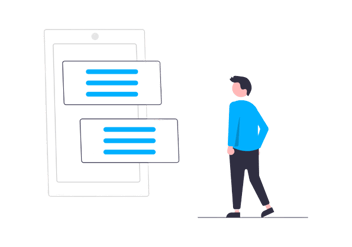How important is customer service in B2B businesses?
When you think of customer service, chances are you think of a typical business-to-customer (B2C) company that deals with individuals. However, customer service also applies to business-to-business (B2B) companies whose clients are multi-faceted organisations.
Is customer service different for B2B companies?
Customer service is all about how a brand supports its customers, particularly when it comes to resolving problems and answering questions. This applies to any business, including both B2B and B2C business models, provided there are people actively investing in what the business sells. After all, whether you sell directly to consumers or to other businesses you’re dealing with the same thing - people.
The difference is, B2C companies are focused on individual customers with personal agendas, while B2B clients are larger and generally more complex. This can mean differing complexities in how you resolve issues and differing outcomes. Let’s explore a few of those differences.
Multiple stakeholders
When it comes to serving a business, there is a balancing act between all the people within the client organisation. While B2C service communicates with one person at a time, B2B relationships are built with teams of multiple people. That means that your brand needs to interact with numerous stakeholders simultaneously, each with their own agenda.
More stakeholders result in a more complicated dynamic because there are more legal hoops to jump through, more contracts to sign, and more people involved in purchasing decisions.
As well as that, organisations have employee turnover, making it difficult to build strong relationships with any particular person. This is why B2B customer service is all about building enduring business relationships that transcend any individual.
Urgent business needs
If you are a B2B company, the product or service you provide has a direct impact on the success of your customer. If a B2B provider doesn’t meet the needs of their customer as planned, it could have a direct consequence to their performance.
Generally, B2B customers rely on these products or services to operate so if there are any issues with supply, delivery, or quality, the results can be detrimental. Since your customers have put their trust in your services and are relying on your commitment to them, you cannot afford to let them down.
Ongoing partnerships
Due to the complicated nature of B2B relationships, the best approach is to build lasting partnerships with your clients. The key with these connections is to interact with multiple stakeholders and work closely with them to find the best possible solution to their needs.
These alliances involve working with account managers, customer success teams, implementation teams, and other major decision-makers. This way, even if one employee from the company leaves, the relationship can continue to thrive. Likewise, within your own team, customer service should be the focus of everyone, not just the customer support team.
How to improve your B2B customer service
To improve your customer service as a B2B provider, there are several core principles that you need to understand. To get started, here’s what you need to know:
1. Balance automation with personal engagement
Since B2B relationships can be more complicated, it’s important to maintain some relatability and human connection where possible. Even though you’re dealing with an overall company, the people within it still require empathy and respect.
While automation and digital technology are beneficial in many applications, don’t let them replace human interactions entirely. Your clients appreciate your support more if it feels personable and customised to their situation, so don’t make the mistake of using templates or robotic tools that may alienate them.
2. Enhance customer support
As a B2B provider, your customers rely on you for their performance so you should always have support services in place to resolve issues as they arise. It is a B2B best practice to invest in around-the-clock customer support, particularly when your clients are in an industry that demands urgent turnaround.
This way, your clients will feel reassured that you are readily available and prepared to help whenever they ask. On the other hand, if you fail to provide the support when they need it, they’re unlikely to renew the relationship.
3. Improve your communication
The ongoing relationships with your B2B clients are based on communication, so you need to ensure you’re doing it well. Your clients require you to be responsive and consistent with communication so that they can always get the answers they need.
Communication with your clients could include:
- Regular email newsletters to share updates
- Customer support calls, emails, message, or in-person conversations
- Packaging and instruction manuals
- Any messaging on your website or app
If your communication is clear, relevant, helpful, and interesting, customers are far more likely to renew their loyalty.
4. Listen to your customers
When it comes to offering exceptional customer service to your B2B clients, you need to engage with their feedback. Feedback holds actionable insights into the Customer Experience (CX) and allows you to understand what is working and what isn’t. Customers know what they want and more often than not, are willing to tell you. All you need to do is ask.
Asking your B2B clients for feedback allows you to learn more about their preferences and expectations so you can effectively cater to them. Since acquiring new customers costs fives time more than retaining loyal ones, this will save you both time and money.
To ask for feedback from your B2B customers, the following are some best practices to implement:
Create an engaging survey
B2B clients tend to be busy so if you’re asking them for feedback, you need to do it in an appealing and meaningful way. Your surveys need to be both interesting and relevant, without asking them to sacrifice too much of their time. The most successful customer feedback surveys are concise, straightforward, relevant, and easy to navigate.
Use quantitative survey metrics
When sending customer surveys, it’s vital to incorporate trackable metrics into them. For example, metrics like Net Promoter Scores (NPS), Customer Satisfaction (CSAT), and Customer Effort Scores (CES), help to measure how well your brand is meeting customer needs. This way, you can take note of changes in customer satisfaction over time, and how any changes influence it.
Choose a communication channel to distribute your survey
To cater to all your customers, you should distribute your surveys using more than one communication method using campaign links. This way, whether your customers prefer email, social media, live chat, your app, or otherwise, you can meet them where they are and get better responses.
Close the customer feedback loop
When your clients answer your surveys, it’s crucial that you evaluate the responses and follow up on them. This is known as the customer feedback loop, in which you ask, assess, and act in a continuous cycle.
With the metrics you implemented into the survey questions, you can collate all the data, identify common trends, and determine what needs to be addressed in the Customer Experience. This way, your clients will trust you to meet their needs and seek improvement wherever possible, rather than simply sticking to outdated methods.
When managing customer feedback, it is essential to have a tool to do all the hard work for you. The intuitive Review Tui software helps to organise all your survey data, extract insights, and streamline the customer feedback process.
Sign up for the Review Tui updates for regularly industry advice and you’ll be the first to know about our software launch later this year.



